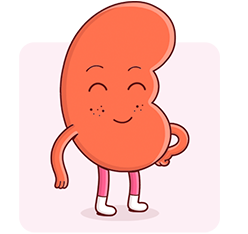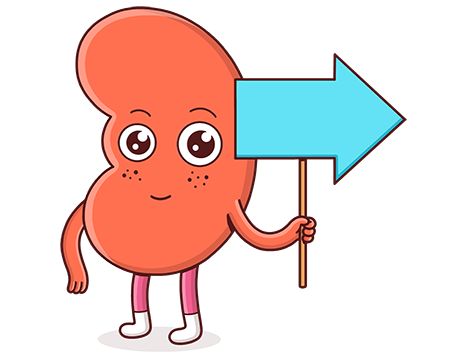Our kidneys are superheroes in our bodies. They do so much for us! Every 30 minutes, they filter all of our blood to clear out waste and toxins, they help control blood pressure, they produce substances that keep our bodies healthy and regulated, and more.
In people with type 2 diabetes, there is increased pressure in the glomerulus (the filtering part of the kidneys). Over time this pressure can damage the kidneys—causing a condition called diabetic kidney disease, or DKD. About 1 in 3 people with type 2 diabetes have DKD. Certain population groups, such as African Americans, Hispanic Americans, and American Indians, have a higher risk of developing kidney failure from type 2 diabetes than Caucasian Americans.
Your kidneys are at risk—and they’re not good at getting your attention.
DKD progresses slowly and silently—often showing no symptoms until later stages.
Diabetic kidney disease progresses slowly and silently—often showing no symptoms until later stages. In other words, your kidneys may not warn you that they’re in danger until things have advanced. People with DKD often don’t know they have it. In the meantime, damage could be building up over time, and the kidneys may eventually fail. People with kidney failure need dialysis (regular time on a machine that cleans the blood), or a kidney transplant; otherwise, serious complications including death may occur.
What do the stages of DKD look like?
There are five stages of diabetic kidney disease, ranging from very mild damage all the way to kidney failure. Blood or urine tests are often used to diagnose diabetic kidney disease. Sometimes, additional tests are needed to determine how well your kidneys are functioning and if there has been any damage.
The stage of DKD you have is determined by your doctor measuring your estimated glomerular filtration rate (eGFR)—or how well your kidneys filter waste from your blood. This test checks how much blood passes through the tiny filters in the kidneys (glomeruli) that remove waste from the blood each minute.
At stage one of DKD, you have mild kidney damage—such as protein in your urine or physical kidney damage—and an eGFR of 90 or higher. At this point, your kidneys are still working well, but—because DKD is progressive—your doctor might have you implement some lifestyle changes to slow down possible kidney damage. These may include:
- Control your blood sugar
- Control your blood pressure
- Eat a healthy diet
- Do not smoke or use tobacco
- Be active 30 minutes a day, 5 days a week
- Stay at a healthy weight
Ask your doctor if there are medicines you can take to help your kidneys and whether you need to see a kidney doctor (nephrologist), even if you already have a general doctor.
At this stage, you have kidney damage, but the amount of protein in your urine or your physical kidney damage is higher, and you may have an eGFR between 60 and 89. This means your kidneys are still healthy and working well, but you may want to talk to your doctor about implementing treatment options and lifestyle changes to help slow the progression of DKD.
At this stage there is further damage to the kidneys, your eGFR is between 30 and 59, and you still may not have any symptoms. If you do have symptoms, they could be:
- Swelling in your hands and feet
- Back pain
- Urinating (peeing) more or less than normal
You are also more prone to complications at this stage—like high blood pressure, a low number of red blood cells (anemia), and bone disease. These complications can be treated with a lower-protein diet to minimize waste products in your blood and medicines that:
- Lower pressure in the glomerulus (the filtering part of the kidneys)
- Manage your blood pressure
- Lower cholesterol levels
- Treat anemia
- Relieve swelling
- Protect your bones
At this point, it is important to implement any lifestyle changes recommended by your doctor. Other ways you can help slow the progression of kidney disease at this stage are by getting a treatment plan from a nephrologist, meeting with a dietitian to help improve your eating habits, and—if you have type 2 diabetes—talking to your doctor about ways you can continue to manage it.
This stage of DKD is the last stage before kidney failure—and, unfortunately, the stage when most people learn they have DKD. Stage four means that not only do you have an eGFR between 15 and 30, but also your kidneys might be moderately or severely damaged—leading to the symptoms and complications listed in stage three. You should seek out regular appointments with a nephrologist, follow a diet plan put together by a registered dietitian, and continue to take any medications as prescribed by a doctor.
At this point, your kidneys have either failed or are getting close to failing. You may have an eGFR of less than 15 and may be experiencing the symptoms of kidney failure, which can include:
- Itching
- Muscle cramps
- Feeling sick and throwing up
- Not feeling hungry
- Swelling in your hands and feet
- Back pain
- Urinating (peeing) more or less than normal
- Trouble breathing
- Trouble sleeping
Your doctor will discuss your treatment options including dialysis or even a kidney transplant.

Speak up for your kidneys. Your doctor—and INVOKANA®—could help.
That’s a lot of scary news about your kidneys—but don’t get discouraged! It's important to know what your risks are so you can make smart decisions for your health. Using a simple blood test, your doctor can detect kidney disease early—and INVOKANA® can be prescribed to help.
When diabetic kidney disease is detected early, there’s a better chance of slowing the progression.
So, if you have type 2 diabetes, speak up on behalf of your amazing kidneys. Make an appointment to talk about your kidneys—and INVOKANA®—today!
To learn more about kidney disease and access other resources, check out the National Kidney Foundation and the American Kidney Fund.
Want to learn more about type 2 diabetes?
Read on about type 2 diabetes.

